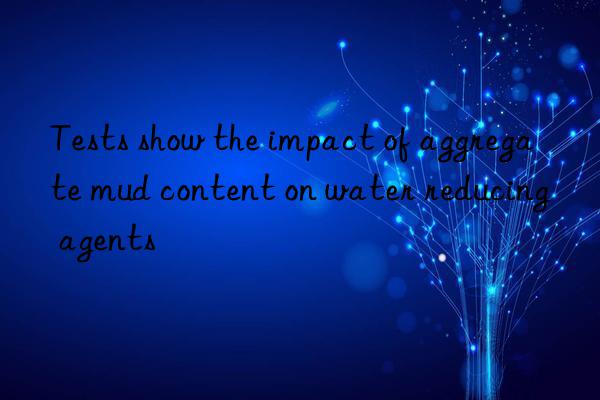
In recent years, water-reducing agents have been widely used. However, in the application of commercial concrete, the sensitivity of water-reducing agents to the mud content in fine aggregates also gives practitioners a headache. Different floor materials have different Seasonal temperature, etc. will affect different test data and building construction area.
If the mud content changes slightly, the slump loss of the mixture will be significantly increased, the working performance will be seriously reduced, and the mechanical properties of the concrete will decline in the later stage. With the continuous expansion of the scale of domestic infrastructure construction, high-quality natural sand resources have become increasingly scarce, and sand with high mud content is directly used in ready-mixed concrete. The development of anti-mud agents is imperative.
Many domestic scholars have studied the impact of mud content in sand on the adsorption of water-reducing agents and have proposed some solutions. The solutions are mainly in two directions: First, amine compounds are embedded in the molecular chain ; Second, develop small-molecule anti-mud agents with preferential adsorption by mud. This test is to compare the mixture properties and mechanical properties of concrete with and without mud inhibitors under different mud contents.
1 Test raw materials
(1) Cement: P·O 42.5 cement, specific surface area 374.6m2/kg, density 3.03 g/cm3, 28 D compression resistance Strength 48. 6. (2) Fly ash: Grade II fly ash produced by Jiujiang Power Plant, fineness 11.8%, water demand ratio 101%, loss on ignition 4.1% (3) Finely ground slag powder: S95 mine produced by Gaoan Southern Building Materials Co., Ltd. Powder: (4) Fine aggregate: Ganjiang natural sand is used, washed with water, and the mud content is 0%. (5) Coarse aggregate: high-safety impact crushing stone with a particle size of 5-25 mm. It has been washed with water and has a mud content of 0%. (6) Water-reducing agent: a high-efficiency water-reducing agent produced by a certain company. When the dosage is 1.2%, the water reduction rate is 21%. (7) Mud: Select it from the sedimentation tank of water-washed sand in commercial concrete mixing station, dry it and grind it into powder. (8) Mud inhibitor: Small molecular weight mud inhibitor synthesized by Qingdao Dingchang New Materials Co., Ltd. The dosage is 0.6% of the total amount of cementitious materials.
2 Test Ideas
Design the C30 concrete mix proportion according to JGJ55. After fixing the amount of materials and water, add 3%, 5% and 7% of fine aggregate mass respectively. , in order to observe the impact of increasing mud content on the performance and mechanical properties of the mixture, and then add the mud inhibitor and compare the performance with the performance before adding it.
As the mud content increases, the performance of the concrete mixture gradually decreases. When the mud content is within 3%, the performance of the concrete mixture is basically not affected. Adding a mud inhibitor will improve the performance of the concrete mixture. The impact on the performance of the mixture is negligible, and there is no need to add it in actual production applications. As the mud amount gradually increases to 5% and 7%, the initial slump and expansion of the mixture begin to decrease, and the slump over time in 1 hour , The expansion loss is significantly reduced. Based on the average transportation time of commercial concrete of 40 minutes, when the concrete with good workability mixed in the station is transported to the construction site for pouring, it is difficult to pour the concrete normally.
Summary of the test of water reducing agent on sand and gravel content
(1) When the mud content of the sand is within 3%, no mud inhibitor can be added, and the mix ratio can be fine-tuned . (2) The use of mud inhibitors for concrete with a sand mud content of more than 3% can effectively reduce slump loss. (3) When the sand mud content is more than 3%, the strength of concrete decreases significantly. (4) Mud inhibitors cannot improve the impact of mud on strength. Sand and gravel with too high mud content should be avoided as much as possible. If there is no replacement condition, the water-cement ratio should be increased and the mix ratio should be verified before use with caution. Even so, concrete may crack. The risk remains uncontrollable. </p



 微信扫一扫打赏
微信扫一扫打赏
